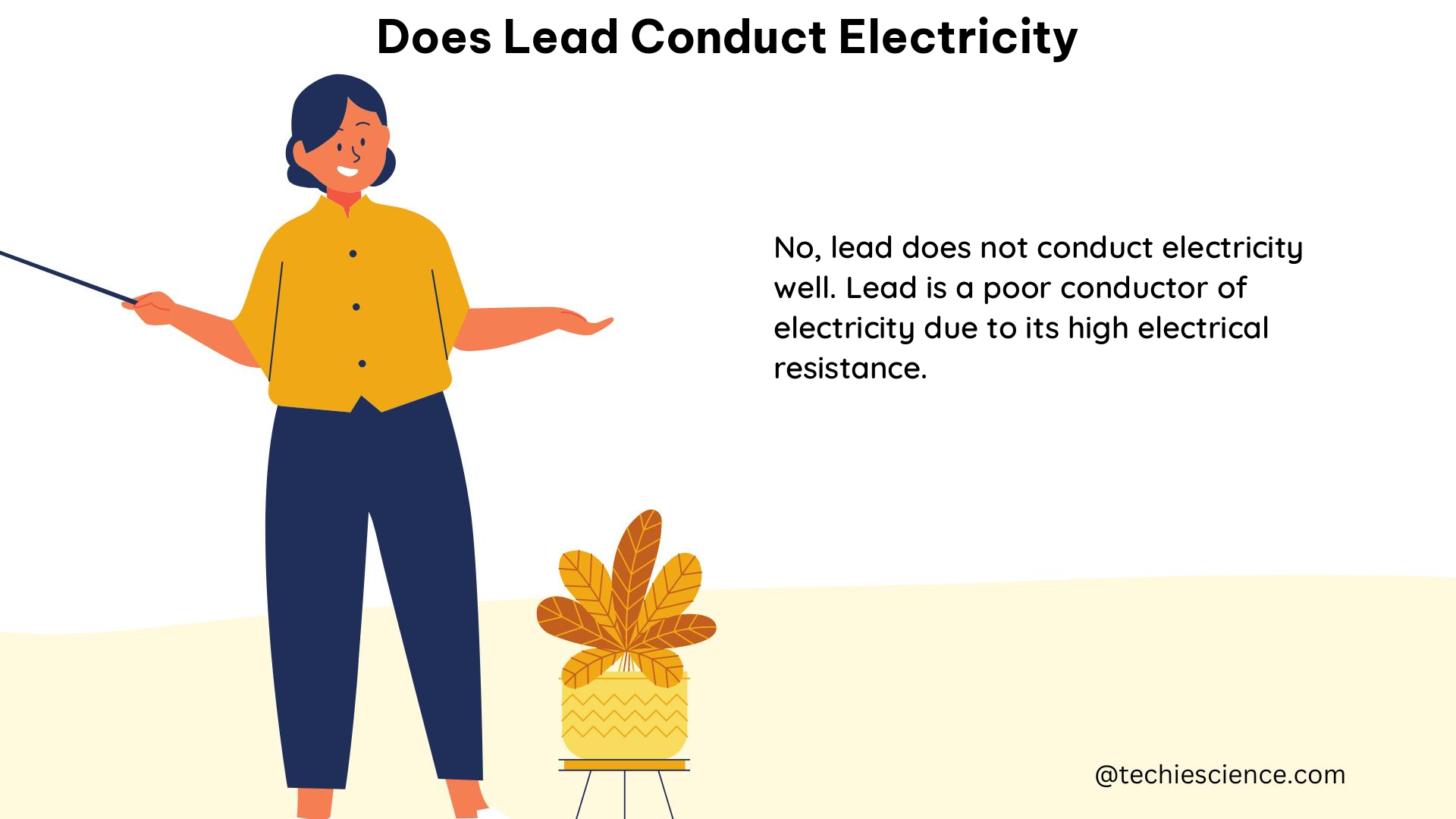Lead is a metal that does conduct electricity, but it is not as efficient a conductor as some other metals like silver, copper, and gold. In this comprehensive guide, we will delve into the technical details of lead’s electrical conductivity, explore the factors that affect it, and compare it to other commonly used conductive materials.
Understanding Electrical Conductivity
Electrical conductivity is a measure of a material’s ability to allow the flow of electric current. It is the reciprocal of electrical resistivity, which is the measure of a material’s resistance to the flow of electric current. The higher the conductivity, the better the material is at conducting electricity.
The electrical conductivity of a material is determined by the number of free electrons available for conduction and the ease with which these electrons can move through the material. Metals, such as lead, are generally good conductors because they have a large number of free electrons in their atomic structure.
Lead’s Electrical Conductivity

Lead has an electrical resistivity of 22 nanoohm-meters (nΩ·m), which is higher than the resistivity of silver (1.59 nΩ·m), copper (1.68 nΩ·m), and gold (2.44 nΩ·m). This means that for a given length and cross-sectional area, lead will have a higher resistance to the flow of electric current compared to these other metals.
In terms of electrical conductivity, which is the reciprocal of resistivity, lead has a conductivity of 45.5 × 10^6 Siemens per meter (S/m), while silver has a conductivity of 63.0 × 10^6 S/m, copper has a conductivity of 59.6 × 10^6 S/m, and gold has a conductivity of 41.1 × 10^6 S/m. This indicates that silver is the best conductor among these metals, followed by copper, gold, and then lead.
Factors Affecting Lead’s Electrical Conductivity
The electrical conductivity of lead can be influenced by various factors, including:
-
Temperature: Increasing the temperature of a conductor, such as lead, will decrease its conductivity and increase its resistivity due to the thermal excitation of the atoms.
-
Impurities: Adding impurities to a conductor, like lead, will decrease its conductivity by hindering the flow of electrons.
-
Crystal Structure and Phases: The crystal structure and phases of a material can affect its electrical conductivity. Different crystal structures and phases of lead may have varying conductivity properties.
-
Electromagnetic Fields: Applying an external electromagnetic field can influence the conductivity of a material, including lead, by affecting the movement of electrons.
-
Frequency: The conductivity of a material can also be affected by the frequency of the electric current flowing through it.
Comparison with Other Conductive Metals
To better understand lead’s electrical conductivity, let’s compare it to some other commonly used conductive metals:
| Metal | Electrical Resistivity (nΩ·m) | Electrical Conductivity (S/m) |
|---|---|---|
| Silver | 1.59 | 63.0 × 10^6 |
| Copper | 1.68 | 59.6 × 10^6 |
| Gold | 2.44 | 41.1 × 10^6 |
| Lead | 22.0 | 45.5 × 10^6 |
As you can see, silver has the lowest resistivity and the highest conductivity among the metals listed, making it the best conductor. Copper and gold also have lower resistivity and higher conductivity compared to lead, indicating that they are better conductors.
Applications of Lead’s Electrical Conductivity
Despite its relatively lower conductivity compared to other metals, lead still finds use in various applications due to its other properties, such as its high density, malleability, and resistance to corrosion. Some applications of lead’s electrical conductivity include:
-
Batteries: Lead-acid batteries, commonly used in vehicles, rely on lead’s ability to conduct electricity to store and release electrical energy.
-
Shielding: Lead’s high density makes it an effective material for shielding against radiation, such as in X-ray equipment and nuclear facilities.
-
Soldering: Lead is used in solder alloys due to its ability to conduct electricity and its low melting point, which facilitates the soldering process.
-
Electrical Contacts: Lead is sometimes used in electrical contacts and connectors due to its corrosion resistance and ability to conduct electricity, although it is often replaced by other metals with higher conductivity.
Conclusion
In summary, lead is a metal that does conduct electricity, but it is not as efficient a conductor as some other metals, such as silver, copper, and gold. Lead has a higher electrical resistivity and lower electrical conductivity compared to these other metals, which means that it has a higher resistance to the flow of electric current.
The electrical conductivity of lead can be influenced by various factors, including temperature, impurities, crystal structure and phases, electromagnetic fields, and frequency. Understanding these factors is crucial when working with lead in electrical applications.
While lead may not be the best conductor among the metals, it still finds use in various applications due to its other desirable properties, such as its high density, malleability, and resistance to corrosion. As with any material, the choice of using lead in an electrical application will depend on the specific requirements and trade-offs involved.
References:
- Electrical conductance – Wikipedia. (n.d.). Retrieved from https://en.wikipedia.org/wiki/Electrical_conductance
- Which Metal is the Best Conductor of Electricity? – Tampa Steel. (n.d.). Retrieved from https://tampasteel.com/best-metals-conduct-electricity/
- Electrical Resistivity and Conductivity – The Physics Hypertextbook. (n.d.). Retrieved from https://physics.info/resistivity/
- Lead – Properties, Applications, and Characteristics – AZoM. (n.d.). Retrieved from https://www.azom.com/article.aspx?ArticleID=7763
Hi…I am Keerthana Srikumar, currently pursuing Ph.D. in Physics and my area of specialization is nano-science. I completed my Bachelor’s and Master’s from Stella Maris College and Loyola College respectively. I have a keen interest in exploring my research skills and also have the ability to explain Physics topics in a simpler manner. Apart from academics I love to spend my time in music and reading books.
Let’s connect through LinkedIn